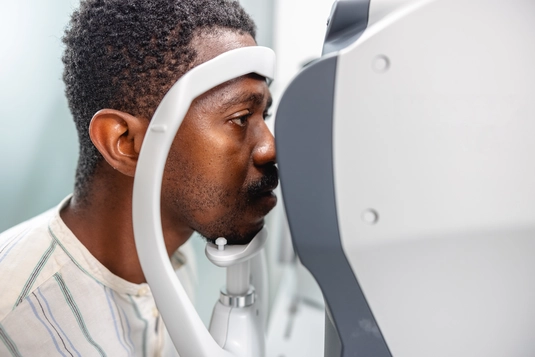Diabetic Eye Exam
in Brampton | Cambridge

Protect Your Vision, Protect Your Future: Expert Diabetic Eye Exam
At G&G Eye Doctors, we understand the importance of healthy vision, especially for those living with diabetes. That's why we offer comprehensive diabetic eye exams designed to detect and manage early signs of diabetic eye disease, so you can enjoy healthy vision throughout your life.
Seeing Beyond the Surface:
- State-of-the-Art Technology: We utilize cutting-edge equipment such as retinal imaging to assess the delicate structures of your eyes for potential diabetic eye complications.
- Specialized Expertise: Our experienced optometrists have extensive knowledge in managing diabetic eye complications like retinopathy, cataracts, and ocular strokes.
- Early Detection Saves Sight: Regular eye exams are crucial for identifying early signs of damage before it impacts your vision permanently.
- Personalized Care: We create customized treatment plans, monitor your progress over time, and work closely with your endocrinologist and primary care physician to ensure optimal eye health.
Diabetic eye disease is a leading cause of preventable blindness.
Millions of Canadians face the risk of diabetic eye disease, a silent threat to your vision. But early detection can make all the difference. At G&G Eye Doctors, we offer comprehensive diabetic eye exams with cutting-edge technology and specialized expertise to catch potential problems before they impact your sight.
Our commitment to protect your future:
Diabetic Eye Exams - Frequently Asked Questions
The general guideline is for an annual exam (once a year) to screen for diabetic retinopathy and other eye conditions that can be associated with Diabetes. Note, this can vary based on the individual's condition and the doctor's recommendations.
- Early detection: Up to 73% of people with diabetic retinopathy are unaware they have it [i]. Early detection through eye exams allows for timely treatment and significantly reduces the risk of vision loss.
- Treatment effectiveness: Studies show that early detection and treatment of diabetic retinopathy can reduce the risk of severe vision loss by up to 90% [i].
A diabetic eye exam is generally covered by OHIP, which provides coverage for a basic diabetic eye exam once per year for patients with diabetes. However, it's important to understand the difference between a basic and comprehensive diabetic eye exam, as the latter includes additional tests that may not be covered by OHIP.
Diabetic Eye Exam:
- • This exam typically includes a visual acuity test, pupil dilation to allow the doctor to examine the retina and optic nerve for signs of damage, and basic screening for any diabetic retinopathy or other eye-related conditions.
- • OHIP covers this basic exam annually for those diagnosed with diabetes, focusing on identifying any immediate changes that could indicate diabetic complications in the eyes.
Comprehensive Diabetic Eye Exam:
- • A comprehensive exam includes all the elements of a basic exam but adds several advanced imaging and diagnostic tests. These can include Optical Coherence Tomography (OCT) scans, visual field tests (HVF), and fundus photography.
- • OCT scans provide detailed cross-sectional images of the retina, revealing the layers beneath the surface which can be crucial for early detection of diabetic changes.
- • Visual field tests help to detect any vision loss due to damage to the optic nerve or retinal changes.
- • Fundus photography captures detailed images of the retina, optic nerve, and blood vessels, providing a record to track changes over time.
- • These additional tests are not covered by OHIP and might incur out-of-pocket expenses or require private insurance coverage.
At G&G Eye Doctors, our priority is your ocular health. We always recommend a Comprehensive Diabetic Eye Exam to aid in the earliest of detection. If you have questions, our Doctors and Staff would be happy to assist and guide you to the most appropriate eye exam tailored just for you.
The Importance of OCT Scans in Diabetic Eye Care
An OCT scan is important during an eye exam for people with diabetes because it provides a detailed picture of the retina, allowing for early detection and monitoring of diabetic retinopathy (DR). Here's why it's crucial for diabetics:
Early Detection:
Diabetic retinopathy often progresses without noticeable symptoms in the early stages. OCT can pick up subtle changes in the retina's structure, like swelling (edema) or thinning of the retinal layers, before vision is affected. This allows for early intervention to potentially prevent vision loss.
Monitoring Treatment:
If you're already diagnosed with diabetic retinopathy, OCT helps track the effectiveness of treatment like injections or laser therapy. By visualizing changes in the retina, doctors can adjust treatment plans as needed.
Detailed Imaging:
Compared to a regular dilated eye exam, OCT offers a much more magnified and precise view of the retina's layers. This detailed information is crucial for assessing the severity of diabetic retinopathy and identifying specific areas that might require treatment.
An OCT acts as a powerful tool for safeguarding vision in diabetic patients by enabling early detection and close monitoring of diabetic retinopathy. Schedule your eye exam today at G&G eye Doctors to ensure your vision is protected with OCT imaging.
Protect your vision with OCT Scans for Diabetics
Importance of OCT Scans for early detection of Diabetic retinopthy